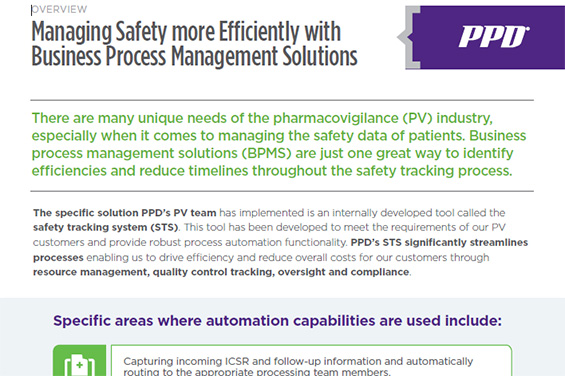
Our Solution to the Business Process Management Tool Needed to Maximize the Use of a Safety Database

Abiola David, pharmacovigilance director, Raza Mohammed, pharmacovigilance director, Neil Walker, optimization associate director of pharmacovigilance and regulatory affairs, and Brian Wellins, senior director of pharmacovigilance and regulatory affairs, write about our business process management solution and its benefits.
Modern safety databases are excellent at capturing safety information and enabling users to prepare submissions to regulatory authorities. However, they do not have the capability to provide users with the oversight needed to manage workflow across a team. They also do not provide detailed information needed to properly ensure compliance, metrics around case processing, or functionality to help manage resources and quality.
These key steps are important as they provide oversight on the full journey of a single case from point of receipt through submission. With more complete oversight, robust practices can be put in place to ensure cases get to the regulatory authority on time in good quality.
To address these gaps, the PPD™ clinical research business of Thermo Fisher Scientific decided to implement a business process management solution (BPMS) to work in conjunction with the safety database (SDB). The BPMS was thoughtfully designed to add functionality above and beyond the SDB capabilities. It also adds flexibility to rapidly adapt business processes to changing regulatory requirements and specific client needs.
The specific BPMS we implemented is an internally developed tool called the Safety Tracking System (STS) that is customized to meet the unique needs of the pharmacovigilance (PV) industry. Below are the ways in which the STS has improved oversight of the timeliness, assignment and quality of the cases in the safety database:
Process automation
STS provides a robust automation functionality that enables us to streamline many of the PV processes, including processing individual case study report (ICSR) reporting. The tool significantly improves our processes, enabling us to drive efficiency and reduce overall costs. Specific areas where these automation capabilities are used include:
- Capturing incoming ICSR and follow-up information and automatically routing to the appropriate processing team members. This significantly reduces the amount of time spent on intake activities and helps to ensure information is not misrouted.
- Generating and tracking of follow-up queries to ensure due diligence through multiple follow-up attempts. This reduces the overall time spent on follow-up activities and improves timeliness of follow-up requests and the processing of responses.
- Collating and filing documentation to the electronic trial master file (eTMF). Documentation includes both source documentation and documentation generated during case processing activities (e.g. client notifications, draft CIOMs, site queries/responses, medical review). This reduces the amount of time spent reviewing the trial master file and ensures documentation is filed in a more timely manner.

Management of case processors
STS automatically assigns cases to individual users based on resource availability. It also provides robust functions for monitoring user productivity and adjusting resource assignments as needed. Managers utilize the system to review real-time case processing information, which includes total numbers of cases, due dates, case prioritization, where cases are in the process and case assignments across users.
This gives managers the information they need to quickly identify potential resourcing issues. The system then provides managers with the robust tools they need to quickly reassign work as needed. These advanced resource management capabilities provide much more granularity and control than the basic group assignment capabilities found in most safety databases, in which items are assigned to a group of users who have to claim their own work. Using STS enables PV management to ensure the most efficient allocation of resources and effectively manages fluctuations in case volumes.
QC tracking
STS ensures that quality control checks are performed in line within our business processes and captures detailed data around those checks. This enables PV to identify and correct quality issues before the final submissions are completed. Additionally, the data captured during the quality checks enables PV management to measure quality at both an individual user and project level. It also readily identifies any quality trends to target areas for improvement activities. Using STS to capture and monitor quality control checks helps PV ensure that the highest quality deliverables are provided.
Oversight/compliance
STS provides a full range of metrics to provide real-time oversight of PV processes, enabling us to ensure compliance with all regulatory and client timelines. This includes the number of open/closed cases, cases completed/submitted within timelines, open cases with outstanding follow-up queries, counts on the number of queries generated, and quality user performance metrics.
Benchmarks
STS enables the PV team to compare processing metrics across all our clients to establish processing benchmarks. This information is critical in driving our continual process improvement strategy and enabling us to constantly refine and improve. Comparing benchmarks across customers enables us to identify when a client-specific process falls outside the norm. Benchmarks also enable us to identify and target specific areas for potential efficiency gains.
Process integration/customization
The BPMS capabilities of STS enable the rapid automation of new workflow process. This has allowed us to automate additional PV functions beyond core ICSR processing.
These include literature reviews, safety reporting to regulatory authorities and ethics committees, electronic trial master filing (eTMF), aggregate reporting tracking and medical monitoring functions, including the processing of physician assessment diagnostic forms (PADFs) and various medical reviews.
The rapid automation capabilities of STS also enable us to quickly tailor existing workflows to meet changing regulatory requirements and to meet the specific needs of our clients.
Using a single BPMS to automate processes enables related PV functions to be easily integrated into a single common framework for capturing metrics across all of PV, resulting in a holistic way of executing and managing PV.
In summary, we have found that implementing a BPMS has significantly improved the efficiency of our processes and allocation of resources, enabling us to provide more cost-effective solutions. In addition, use of BPMS provides increased oversight of every case at each point in the processing cycle, leading to better quality cases, timely submission and improved customer experience.